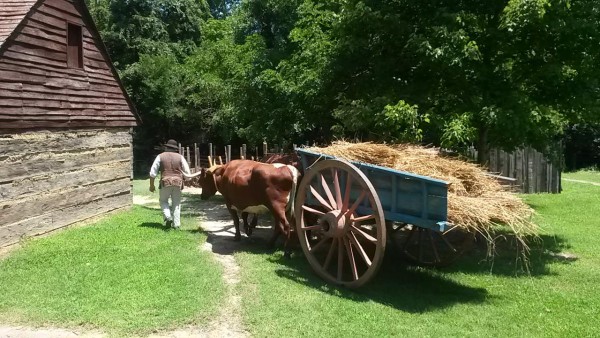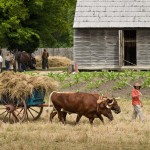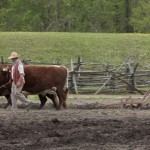The tent is still standing. And it’s still watertight, even after six months of sun, rain, and even a little bit of snow.
It’s a tent constructed of wood, straw, and rope, and it stands not only as evidence of an 18th-century technique brought to life, but also as proof of the endless curiosity and collaboration practiced by our interpreters.
It started with a question. Military interpreters wanted to know what it took to build a shelter they had seen pictured and described in the archives. They knew that soldiers during the Revolutionary War sometimes constructed straw tents. Now they wanted to put themselves in their place.
And it was made possible by the Historic Farmers at Great Hopes Plantation, who grew, harvested, and delivered the crop. Because that’s the kind of thing they do.
In the process, everyone learned something new. Some mistakes were made, but understanding was refined, guests were engaged, and the past came a little bit more alive.
It started back in the Fall of 2014. Two-thirds of an acre of winter wheat was planted in a field at Great Hopes. During the winter months the wheat just looked like grass. But by the time it matured in June, the wheat stood three feet tall.
When it was fully grown, the farmers used sickles to cut it. “When you harvest wheat,” explained apprentice historic farmer Cameron Green, “you wait for the opportune moment when it’s dried out enough that it won’t get moldy or begin to ferment. You want it to be a hard grain, but not so dry that it falls out while you’re trying harvesting it.”
The wheat was laid down and tied into sheaves with the heads (the part with the grain) all pointed in the same direction. This work was commonly done by women and children.
The sheaves of wheat were tied into a “shock,” a pinwheel shape with the heads pointed inward. In the 18th century, these wheat stacks could be up to 20 feet high. The stack was an efficient way to stage the crop. They were sized to whatever a farm could thresh out in a day because once you started taking it apart you would be making the wheat vulnerable to the elements.
The farmers used a flat bat (like a cricket bat) to smack the piles firmly into place.
Then they invited guests to help with the next step, threshing the wheat, when the grain was separated from the stalk. The seed had to be beaten out of the grass blade using a flail (below left). What was left was the thresh (wheat and chaff) and straw.
The next step was to wait for a breezy day. Really.
After a tarp was spread on the ground, the thresh was placed in a large round winnowing basket (above right). By tossing it gently, the grain would fall through while the light chaff floated freely and out of the basket. Not an especially high-tech step, but effective.
Most wheat ended up being sent to be ground. After being milled, the wheat flour usually ended up in the urban areas. Country bread was corn bread.

18th-century wheat farmers ended up with a lot of straw as a byproduct of the process. Many would just burn it, but in Virginia many actually fed it to livestock during the winter. Not that that was the best option. What nutritional value it contained was in the little bit of grain missed during the threshing. But it would fill them up a little bit. Cameron noted that travelers often commented on the poor treatment of animals by Virginia’s farmers.
Straw became more useful when the military came to town-mainly for bedding, but also, on occasion, for shelter. So that’s how nearly all of the two-thirds of an acre of straw ended being delivered to the military encampment in July 2015.
Carrie MacDougall and Katie Van Duinen led the effort to build the shelter. First, they erected a frame using lengths of wood harvested off-site. A half hitch cinched the frapping, securing the lengths of wood tightly together. (That’s Katie pointing out the frapping below.)
“Once you’ve got the framework, you can tie just about anything on it,” said Carrie. Even ripped pieces from old tents. In this case, it was straw, which would have been plentiful in the 1700s.
But why build a straw tent at all? Well, during the Revolution, textiles were in short supply since the colonies were fighting their main supplier. Cloth was at a premium because most trade was cut off.
Orderly books, in which the military kept track of all the orders received through the chain of command, include instructions for soldiers to clean out their tents “every fine day” by removing the straw on the ground, letting it air out, and replacing it with a fresh supply.
They must have used a lot of straw.
“We thought it was an important aspect of military life that we hadn’t shown before,” said Carrie. It was also something guests could help construct.
Visitors to the military encampment, especially kids, helped put the bundles of wheat together and tied them onto the frame.
There was definitely a learning curve. Carrie readily admits they might have used more straw than they actually needed. (It’s a slightly fluffy shelter.)
“It would have gone a lot faster if you had a rope and the bundles and you were weaving them as you go.” With two people working in tandem, starting at the bottom and working up, Carrie estimates that two soldiers could have put it up in a day, rather than the casual six weeks or so it took them.
Starting at the bottom also layers the wheat in such a way that it easily sheds water.
Light peeking through a few spots on the roof shows where squirrels feasted on bits of grain left on the stalks of straw. But even with the holes, the shelter is still watertight. It’s also cozy, retaining some heat in the cold of winter. Carrie estimates that it was also about ten degrees cooler during the summer.
Normally, the shelter would have been entirely enclosed, but they left a space on one end and decided not to add a door on the other. It would have been airtight, not to mention dark.
Carrie and her colleagues saw drawings that showed a rope running the length of the shelter on either side, but they weren’t sure why it was there. When you try to bend the wheat over the top, it tends to pop up rather than folding neatly over. They quickly learned that the rope helped to keep everything in place, and especially kept everything dry.
Time will tell just how long it stays that way. But for now, it remains in place, even as it is expected that military programs might be concentrated at the Magazine rather than the Military Encampment this season. But take a look the next time you approach the corner of Nicholson and Botetourt.



Mike Van Duinen says
Go Katie a job well done .
Barbara says
Very interesting! thank you for sharing this.
Bob Burgess says
This type of shelter was common in the woods and coppices of Britain and France - where single workers or even whole families spent most of their working lives. Known in France as a hutte or loge de bûcheron (woodcutters hut) many were photographed and appear on post cards - a simple Google search using the above will find hundreds of examples. Used by woodcutters, clog makers, hoop makers, tent peg makers, rake makers, hurdle makers and many others they often only lasted a single season. As the wood was used up, they had to move to a new area and start again - for coppice on a 5 to 10 year rotation.
Bob Burgess says
Here’s an example
My daughter and I were there over labor day when they were still constructing the “tent”. I thought it was a very smart way of using plentiful resources. It will be interesting to see how long it lasts. I would think it might last a few years even. Wouldn’t it be kind of like a “thatched roof”? Counting the days till spring break so we can get our next Williamsburg experience.
My wife and I had a nice conversation with either Carrie or Katie when we spent our second seven day Colonial Williamsburg vacation of the year last November. We were given a lot of information on the wheat shelter and how well it was working. It was interesting. It was a somewhat cool day and my wife got a kick out of how warm it was in the structure.
It was, as all of them are, another fun, educational interaction with an interpreter.